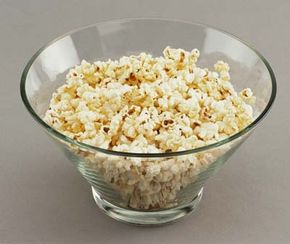Popcorn certainly is unique. You toss a flat pouch no larger than a wallet into a microwave oven and in three minutes, it has expanded to a volume 40 or 50 times its original size. Not too many other foods act this way.
There are three elements that make popcorn work like this:
Advertisement
- Moisture inside the kernel
- Starch inside the kernel
- The hard shell surrounding the kernel
When a popcorn kernel heats up (either in a popcorn popper or in the microwave), the moisture inside the kernel expands. Moisture is extremely important to a popcorn kernel. Unless the percentage of moisture in the kernel is just right, the kernel won't pop. When the pressure inside the hard shell gets high enough, the kernel explodes. That part seems normal enough -- lots of things explode when you heat them.
The strange part is the white solid that forms during the process. According to this article:
There are two things from regular life that behave something like this. The first is bread or muffins, which expand and solidify (although much more slowly). The other is "silly string," which is a liquid that solidifies as soon as it hits air.
Here are three experiments you can perform to get a better understanding of how popcorn works:
- Use a needle or pushpin to puncture the shells of a number of popcorn kernels (be sure to wear glasses when you do this -- it is not as easy as it sounds!). Then try to pop the kernels. They won't pop because the pressure cannot build inside the punctured kernels.
- Let the kernels stand in a warm oven or in the sun for several days, and then try popping them. The oven or sun will dry the kernels out, and make them difficult to pop.
- Try to pop popcorn at a low temperature (below 150 degrees C or 300 degrees F). You will find that the popcorn will not pop -- it has to get beyond a certain temperature for the pressure inside the kernel to build to the point where popping occurs.
Advertisement
